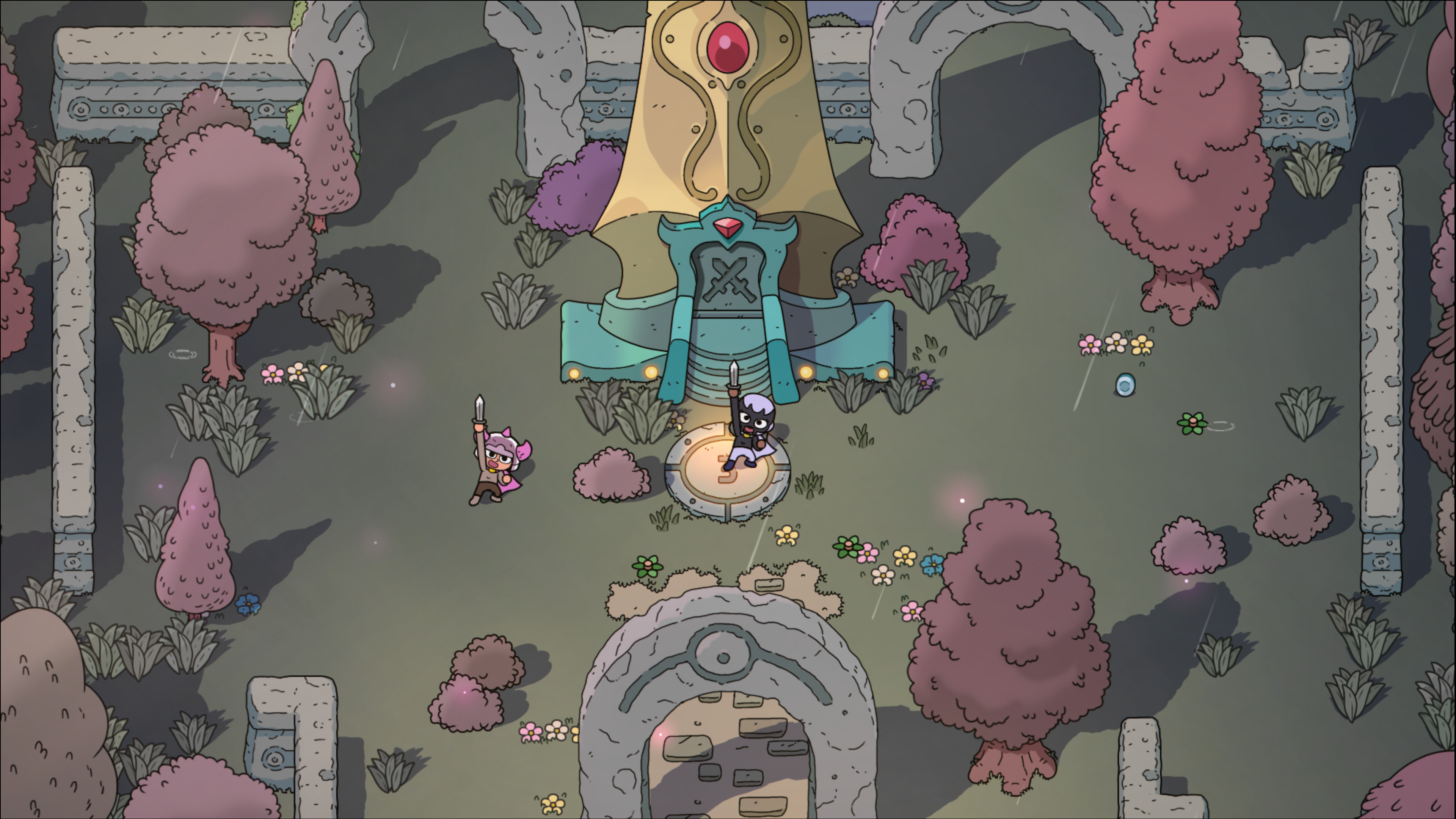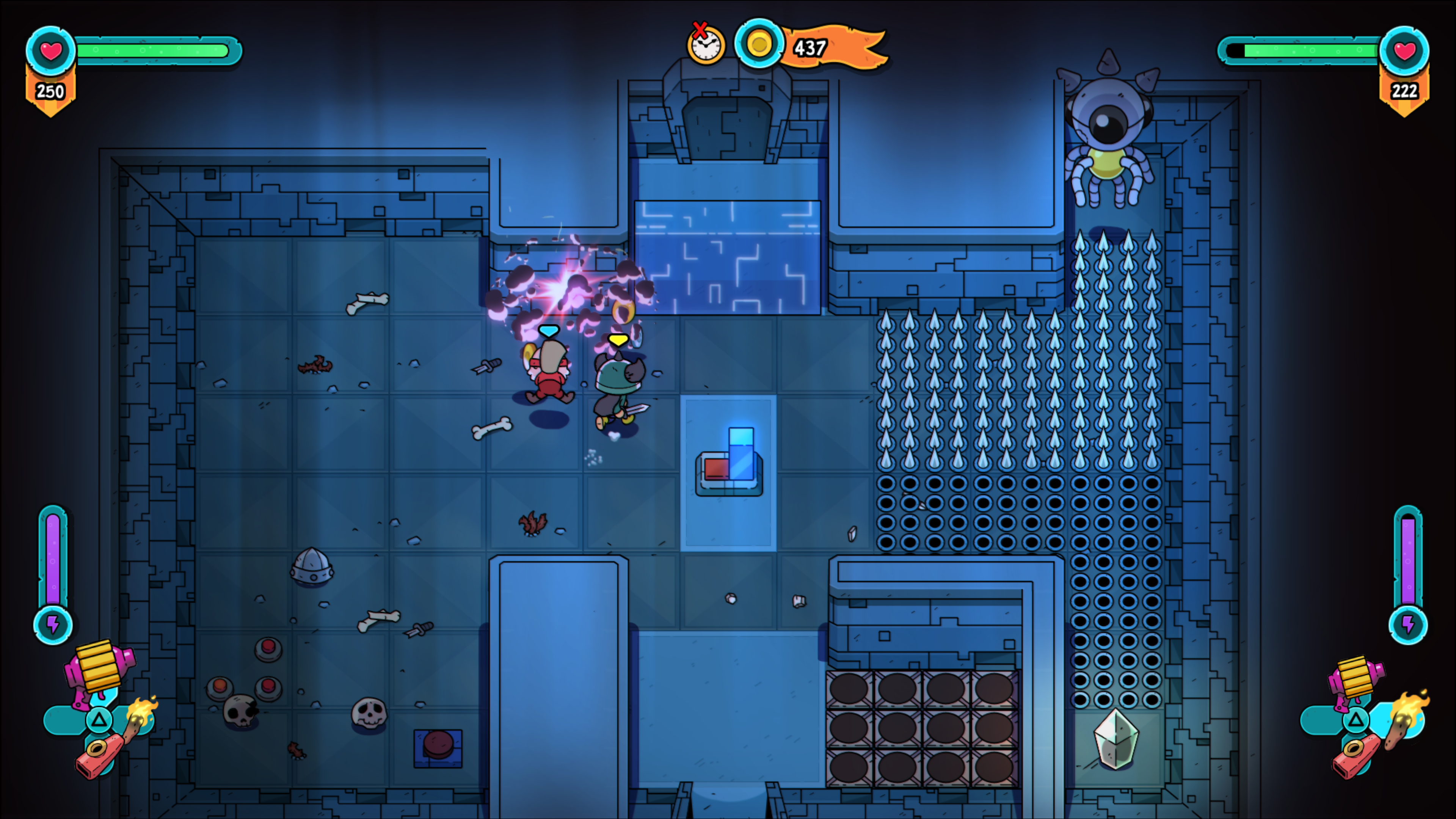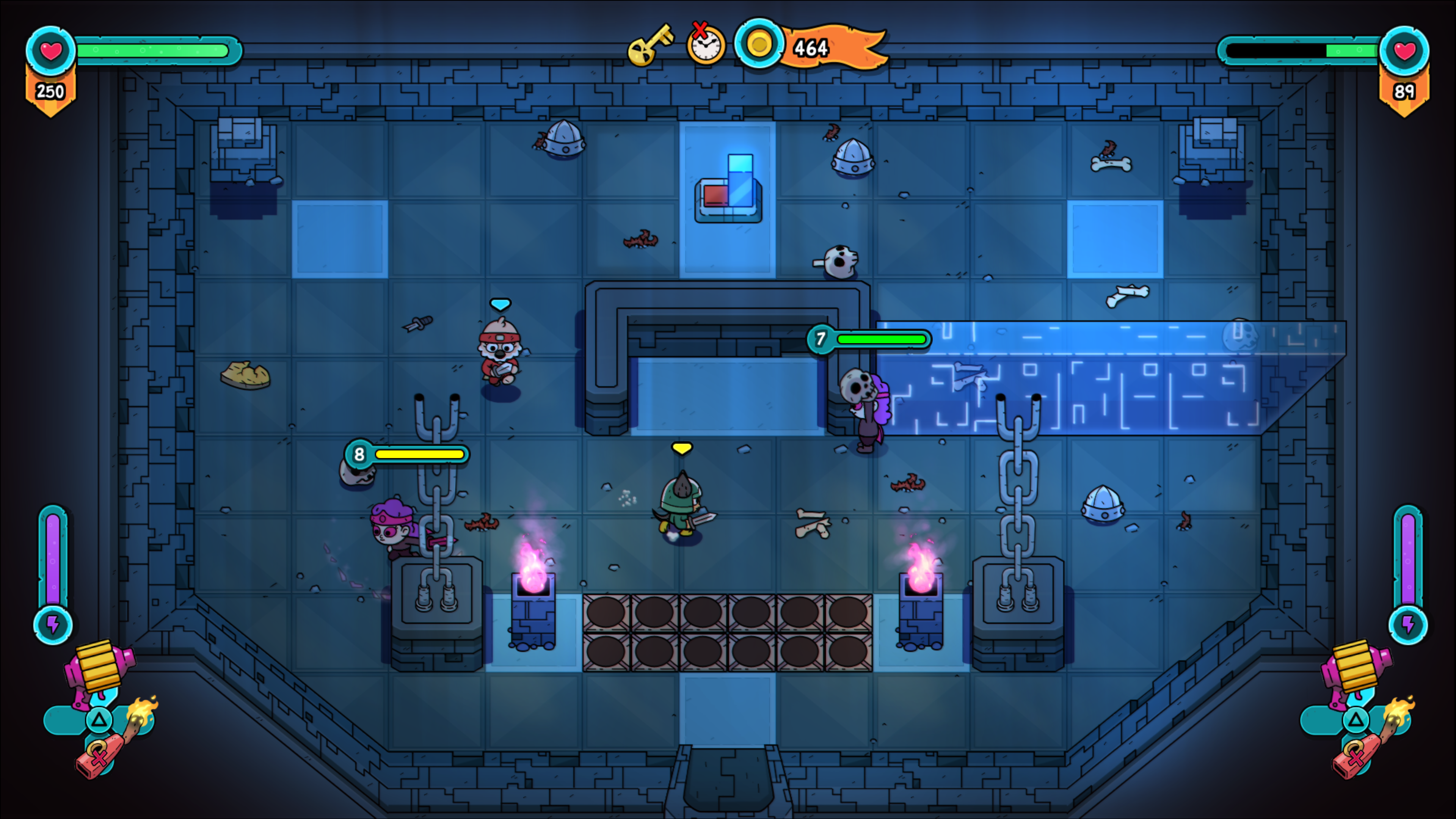I’ve always had a certain attachment to cartoons and their animation style; mainly the way they can be emotive and full of detail while remaining so simple and elegant. The Swords of Ditto, developed by onebitbeyond and published by Devolver Digital, is reminiscent of that same philosophy. It’s a bright, animated roguelike, styled after classic top-down combat-based RPG adventures. Every run is different from the last—the items you receive, the dungeons and monsters you brave, and even the map itself will shift with each life. You and a buddy can partner up in couch co-op to discover what the island of Ditto has to offer, and what secrets may await.
Each run opens with you, the latest “Sword of Ditto,” being awakened by a dung beetle named Puku and informed of your hero status. You must then retrieve the sword from its last owner’s resting place and thus begin your quest. From here, you’ll go through four mini-dungeons: two to obtain Toys of Legend, which act as powerful weapons and puzzle-solvers, and two to destroy Anchors. After grabbing the Toys and using them to destroy the Anchors, you’re encouraged to take on the evil Mormo, though honestly you can try it without going through a single dungeon. You also level up each run, granting you more health and more slots for Stickers, which are equippable items that grant small buffs or new abilities. The world grows stronger too, though, and dungeons only open up once you hit certain levels. This creates a scalable difficulty that persists between each run.

You Take the Flaws, and You Take the Fun
No matter whether you win or lose, the valiant hero does fall, and the circumstances surrounding this will affect the next run. When the succeeding Sword of Ditto awakens 100 years later, the island could be affected by Mormo’s evil. If she has reigned over existence for a century, the world will be dark and rainy, while every building will be worn down. If your last run ended in victory, the land will be happy and rejuvenated. Even the location from which each hero grabs the Sword changes—either in a desolate graveyard or a vivacious memorial in the town square, depending upon how the old hero fared.
For reasons beyond my knowledge, I assumed a certain hinted feature was a sidequest, optional, and a one-time use. It was none of these things. Though the game tends to steer you toward your showdown with Mormo rather than place importance on side content, some of it is absolutely essential to the experience and can completely change how Ditto works. Swords should be upgraded, penguins need to be found, and tokens must absolutely be used. Quests given from NPCs, on the other hand, seemed to take a lot of precious time, and never gave a substantial reward.
Even with power-ups and secrets in hand, every Sword in this world must eventually meet their demise. Simply put, dying sucks. Each run, only currencies and levels persist. No Toys, Stickers, or pickup items will follow you to your new life. Granted, the game gradually becomes more forgiving as you sink time into it, showing you interesting ways to carry your progression with you. Once these progression systems click into place in your mind, Ditto is granted a new layer of depth and replayability.

However, it still utterly sucks to sink an hour or more into a single run, only to die before you can eat to regain health. Players share items and have separate health bars, but drop rates for food feel the same playing together as they do when playing alone. This means you’ll often run out of healing items, or may need to spend all your gold replenishing your stock. Even worse, the first dungeon of the next world will always be locked to one level higher than you currently are. If you fell in combat just as you were about to hit Level 10, awesome! You’ll quickly level up then jump right into your next adventure! If you hit Level 10 then met a quick death, though, you’ll spend the beginning of your next run wasting time destroying enemies, trying to reach Level 11. Though like I said earlier, certain progression systems make this loop ten times more bearable, and much more fun.
Aside from that, many runs may feel similar. Though the land around you is randomized, there are only so many puzzle and dungeon designs possible. This is understandably a difficult point of contention in a roguelike top-down adventure of this caliber. But that raises another good question: does The Swords of Ditto need to be a roguelike? Would its problems exist if it were a 100% hand-crafted experience, where every stashed goodie and brain-thumping puzzle were meticulously designed with your exact moment in mind?
It’s difficult to tell, though I’m sure this idea of a singular adventure was play-tested and ultimately decided against. I’m also sure that many of these variation and balance based problems could easily be fixed by onebitbeyond in future updates. Even so, Ditto’s problems by no means ruin the experience. They are but blips on the radar.
C’mon, Grab Your Friends
This is largely because The Swords of Ditto flaunts a stylistic panache more confidently than any indie I know. It feels like a late 2000s animated series, sure, but this innocent touch permeates throughout the world. Trees hold their cartoonish mouths agape as robots and kitties toss vinyl records, shoot lasers, and play kazoo. The art manages to stay intricate, luscious, and fun without overwhelming the player with detail. It’s the perfect combination of whimsical and practical in every way, from the art and sound design to the gameplay itself. Even if I receive the Laser Ring for the fifth time in a day, it’s consistently fun to annihilate foes with. The Vinyl Frisbee is always a blast to ricochet around the screen. And as a partner and I step into each dungeon knowing we may die soon, I can’t help but smile about the way the experience comes together.
I can’t say The Swords of Ditto is a flawless experience. But I can say that the combat, progression, aesthetic, and couch co-op combine to create something wholly unique and engaging, to the point where I will gladly continue to play long after review, with the hope that future patches may resolve my complaints. The love and attention to detail that went into its conception is apparent and permeates to the player. There’s a lot going on here; a burst of emotion and detail pour out of the experience. Yet somehow, the game remains simple and elegant. The road ahead may be filled with death and sadness, but the kazoos and cartoons keep rolling, making every play session of The Swords of Ditto a real treat.
The Swords of Ditto review code provided by publisher. Version 1.03 reviewed on a PlayStation 4 Pro. For more information on scoring please see our Review Policy here.
-
Top-notch art and sound design
-
Fun, whimsical combat and adventure
-
Engaging progression systems
-
Couch co-op is an absolute blast
-
Some annoying issues with balance and run variation
The Swords of Ditto Review
-
The Swords of Ditto Review

-
The Swords of Ditto Review

-
The Swords of Ditto Review

-
The Swords of Ditto Review

-
The Swords of Ditto Review

-
The Swords of Ditto Review

-
The Swords of Ditto Review

-
The Swords of Ditto Review

-
The Swords of Ditto Review

-
The Swords of Ditto Review









